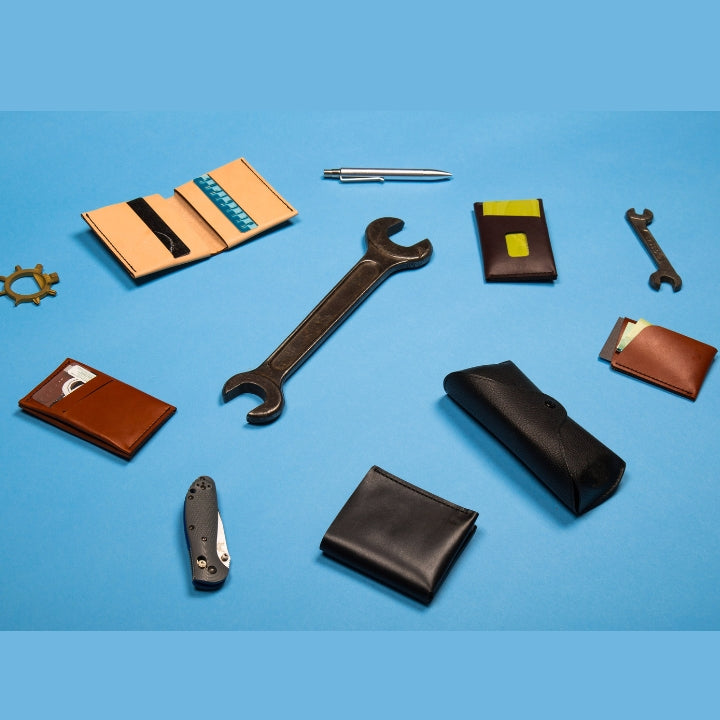
Mastering Leather Care: Preserve, Protect, and Polish
Share
Leather is more than just a material; it's an investment in style and longevity. But to ensure that your leather items, from the sleek jacket in your wardrobe to the luxurious sofa in your living room, maintain their allure, proper care is paramount. This comprehensive guide delves into the art of leather care, providing you with the knowledge and techniques to keep your leather looking its best.
Understanding Leather
Leather is not just a material; it's a testament to durability and elegance. Its timeless appeal makes it a favorite for a wide range of products. However, to preserve its beauty and functionality, understanding its types and traits is crucial.
The Basics of Leather: Types and Traits
There are several types of leather, each with unique characteristics and care requirements:
1. Full-Grain Leather: This is the highest quality leather, featuring the entire grain layer without any removal of the surface. It's known for its durability and ability to develop a 'patina' over time.
2. Top-Grain Leather: A bit more processed than full-grain, top-grain leather has the second layer of the hide. It's thinner and more workable than full-grain but doesn't age to the same extent.
3. Genuine Leather: Contrary to what the name suggests, genuine leather is not the highest quality. It's made from the leftover layers of hide after the top is split off and often coated with a painted surface.
4. Bonded Leather: The lowest quality of leather, bonded leather is made from leftover scraps and fibers bonded together with polyurethane or latex onto a backing.
Each type has its distinct traits, affecting durability, appearance, and care requirements. Full-grain leather, for example, requires careful conditioning to maintain its rugged beauty, while bonded leather needs protective measures to prevent peeling.
Recognizing Quality Leather
Identifying high-quality leather is pivotal in ensuring you're investing in a product that lasts. Here are some tips to help you recognize quality leather:
- Texture and Grain: High-quality leather will have a natural, unpatterned texture. The grain should feel genuine and not like it's been machine-stamped.
- Thickness and Flexibility: Good leather feels sturdy and flexible. It should bend easily but also feel dense.
- Scent and Pores: Genuine leather has a distinctive, rich smell. If it smells like chemicals or plastic, it's likely not high-quality. Also, look closely at the pores; irregularity in the pattern is a sign of natural leather.
Understanding the basics of leather is the first step in providing it with the care it deserves. In the next section, we'll explore everyday leather maintenance to keep your items in top-notch condition.
Everyday Leather Maintenance
Proper maintenance is crucial to extend the life of your leather items and keep them looking as luxurious as the day you bought them. Regular cleaning and proper storage are the cornerstones of leather care. Let's explore how you can incorporate these practices into your routine.
Routine Leather Cleaning
Regular cleaning is essential to prevent the build-up of dirt and oils that can degrade the leather over time. Here's how to keep your leather clean and pristine:
1. For Light Cleaning:
- Use a soft, dry cloth to dust the surface.
- For a slightly deeper clean, lightly dampen the cloth with water and gently wipe the leather.
2. For Thorough Cleaning:
- Use a specialized leather cleaner. Apply a small amount to a soft cloth and gently rub it onto the leather in circular motions.
- **Avoid harsh chemicals**: Products like bleach or household cleaners can damage leather. Always use cleaners specifically designed for leather.
3. DIY Leather Cleaning Solutions:
- For a natural option, mix equal parts water and vinegar. Dip a soft cloth into the solution, wring it out, and gently wipe the leather. The mild acidic nature of vinegar helps in cleaning without damaging the leather.
Tip: Always test any cleaner on a small, inconspicuous area first to ensure it doesn't cause discoloration or damage.
The Art of Storing Leather
Proper storage is just as important as cleaning when it comes to maintaining the integrity of leather. Here are some tips to store your leather items correctly:
- Keep it Cool and Dry: Store leather in a cool, dry place away from direct sunlight. Excessive heat or moisture can lead to cracking and mold growth.
- Maintain Shape: Fill bags or shoes with soft materials to help them maintain their shape. Use a padded hanger for leather jackets to prevent stretching.
- Breathability is Key: Never wrap leather items in plastic. Leather needs to breathe, and plastic coverings can promote the growth of mold and mildew. Opt for a breathable fabric cover instead.
Here's a nice table to simplify everything:
| Leather Item | Storage Tip |
| Jackets | Use padded hangers; avoid folding to prevent creases |
| Bags | Stuff with soft material; store in a dust bag |
| Shoes | Use shoe trees; store in a dry place away from direct sunlight |
Regular maintenance not only keeps your leather looking great but also prevents premature aging and damage. In the next section, we will delve into more specialized leather care techniques to tackle specific issues and keep your leather in the best possible condition.
In-Depth Leather Care Techniques
Beyond everyday maintenance, leather often requires more in-depth care to address specific issues like dryness, scratches, or exposure to the elements. Here, we'll explore advanced techniques for keeping your leather supple, strong, and stunning.
Leather Conditioning: Keeping It Supple
Leather, much like skin, can dry out and lose its flexibility. Conditioning helps maintain its moisture, ensuring it stays soft and doesn't crack.
1. Choosing a Conditioner:
- Opt for a quality leather conditioner that's appropriate for your type of leather. Note that some products are formulated specifically for certain leather types (e.g., suede, nubuck).
2. Application:
- Apply a small amount of conditioner to a soft cloth.
- Gently rub the conditioner into the leather using circular motions. The leather should absorb the conditioner, enhancing its color and texture.
- **Frequency**: Conditioning every 3-6 months is generally sufficient, but this can vary based on the climate and how often the item is used.
3. DIY Conditioners:
- For a natural option, mix one part vinegar to two parts linseed oil. Apply to the leather, let it sit for about 15 minutes, and then buff it with a soft cloth for a natural shine.
Addressing Leather Damage
Even with the best care, leather can get damaged. Here's how to address common issues:
1. Scratches:
- Light Scratches: Often, rubbing the scratch gently with your finger can redistribute the oil in the leather, camouflaging the scratch.
- Deep Scratches: Apply a leather repair cream or balm to the area, smoothing it over the scratch and blending it with the surrounding leather.
2. Cracks:
- Clean the area gently and apply a leather conditioner to moisturize the leather. In severe cases, a leather repair kit may be necessary, or professional help might be the best option.
3. Peeling:
- Peeling usually occurs on low-quality or faux leather. It's challenging to fix but applying a leather binder and filler can improve the appearance temporarily. For a long-term solution, consider seeking professional restoration.
With the right approach, you can address most leather issues at home, keeping your items looking their best for years to come. Next, we'll focus on specialized leather care, diving into the nuances of caring for different leather items like apparel, furniture, and accessories.
Specialized Leather Care
Leather items come in various forms, from stylish jackets and luxurious sofas to essential accessories like bags and shoes. Each type demands specific care considerations to maintain its unique appeal and functionality.
Caring for Leather Apparel
Leather apparel, such as jackets, pants, and skirts, combines style with durability. However, they require particular attention to keep them looking their best:
1. Cleaning and Conditioning:
- Jackets and Pants: Wipe with a damp cloth for routine cleaning. For a deeper clean, use a leather-specific cleaner. Condition every 3-6 months to maintain suppleness.
- Gloves: Hand-wash using a mild soap. Reshape them while they're still damp and allow them to air dry.
2. Storage:
- Hang leather jackets on wide, padded hangers to maintain their shape. Avoid plastic covers; opt for a breathable garment bag instead.
- Store leather pants and skirts in a dry, cool place, ideally laid flat or hung on clip hangers to avoid creases.
3. Seasonal Care:
- Be mindful of the weather; leather can be damaged by excessive moisture or dry heat. In rainy weather, ensure your leather apparel is dried properly if it gets wet.
Leather Accessory Upkeep
Accessories like bags, belts, and wallets often face daily use, making their care crucial:
1. Regular Cleaning:
- Wipe down leather accessories with a damp cloth. For bags, empty them first and consider using a leather cleaner for a more thorough clean.
2. Shape Maintenance:
- Stuff bags with soft materials to maintain their shape when not in use.
- Hang belts on a rack or roll them loosely to prevent warping.
3. Moisture and Stain Prevention:
- Keep accessories dry and clean. If your leather bag gets wet, empty it and let it air dry away from direct heat.
- For stains on wallets or belts, spot clean with a damp cloth and mild leather cleaner.
Leather Care Myths Debunked
Leather care is surrounded by misconceptions and myths that can lead to improper practices and potential damage. It's essential to separate fact from fiction to ensure your leather items receive the best care possible. Here, we address some common leather care myths and reveal the truth behind them.
Myth 1: Leather Is Indestructible
- Reality: While leather is durable, it's not impervious to damage. Exposure to harsh conditions, direct sunlight, and improper care can lead to fading, cracking, and peeling. Regular maintenance is crucial to preserve its strength and appearance.
Myth 2: Leather Doesn't Require Regular Cleaning
- Reality: Like any material, leather accumulates dirt and oils from regular use. Neglecting to clean leather can result in the buildup of grime, leading to deterioration over time. Gentle, regular cleaning is essential to maintain its quality.
Myth 3: All Leather Products Can Be Treated the Same Way
- Reality: Different types of leather (e.g., full-grain, suede, nubuck) have unique characteristics and care requirements. Using the wrong products or techniques can cause damage. It's important to understand the specific needs of your leather item and care for it accordingly.
Myth 4: Leather Can Be Repaired with Any Home Remedy
- Reality: While some minor issues can be addressed with DIY solutions, not all damage can be repaired at home. Using inappropriate methods or products can worsen the problem. For significant damage, professional assessment and repair are recommended.
Myth 5: Conditioning Leather Too Often Is Beneficial
- Reality: Over-conditioning can lead to issues like residue buildup and a loss of the leather's natural luster. It's important to condition leather only as needed (typically every 3-6 months) and to follow the product instructions carefully.
Dispelling these myths is crucial for adopting the correct leather care practices, ensuring your items remain in excellent condition for years to come.
Conclusion
Mastering the art of leather care is about understanding the unique characteristics of leather and adopting a tailored approach to its maintenance. From recognizing the various types of leather and their specific needs to debunking common myths, this guide has navigated through the essential practices to ensure your leather items remain a testament to timeless elegance and durability.
